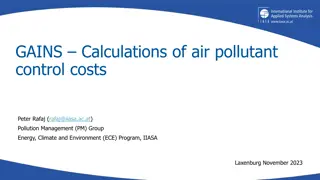Criteria Pollutant Analysis for California's Electric Sector Planning
The analysis focuses on minimizing air pollutants and greenhouse gas emissions, with a priority on disadvantaged communities, as directed by California's Public Utilities Commission. It includes quantifying criteria pollutants within and outside of Disadvantaged Communities (DACs) for the years 2026, 2030, and 2035, using the 25 MMT Core cases. Updates were made to biomass emissions factors to improve accuracy in the analysis.
Download Presentation

Please find below an Image/Link to download the presentation.
The content on the website is provided AS IS for your information and personal use only. It may not be sold, licensed, or shared on other websites without obtaining consent from the author.If you encounter any issues during the download, it is possible that the publisher has removed the file from their server.
You are allowed to download the files provided on this website for personal or commercial use, subject to the condition that they are used lawfully. All files are the property of their respective owners.
The content on the website is provided AS IS for your information and personal use only. It may not be sold, licensed, or shared on other websites without obtaining consent from the author.
E N D
Presentation Transcript
2023 Proposed Preferred System Plan and 2024-25 Transmission Planning Portfolios Supplemental Criteria Pollutant Analysis Energy Division Staff November 2, 2023 California Public Utilities Commission
Criteria pollutant analyses of the IRP PSP 25MMT Core cases for years 2026, 2030, and 2035 California Public Utilities Commission 2
Background criteria pollutants analysis Statute directs the Commission's IRP process to ensure that LSEs "minimize localized air pollutants and other greenhouse gas emissions, with early priority on disadvantaged communities "(PU Code 454.52 (a)(1)(H)) Reports from SERVM studies were post-processed to produce criteria pollutant analyses for the CAISO area only as well as all of California. Analysis quantifies the quantity and breakdown of criteria pollutants within DACs (Disadvantaged Communities) and outside DACs. The following slides present these analyses for 2026, 2030, and 2035 with the 25 MMT Core cases paired with the 2022 IEPR electric demand forecast Refer to 2023 Proposed Preferred System Plan (PSP) Reliability and Emissions Analysis slides for further background on these cases, available here: PSP ruling-Reliability and emissions analysis-slides_2023-10-04- FINAL (ca.gov) Analysis steps using SERVM outputs Methods to estimate start NOx emissions and normal operation NOx emissions Data sources for estimating emission factors Biomass emissions factors were updated this PSP cycle, given new information sourced from RPS contracts. The effect is to lower emissions from biomass, particularly NOx emissions. Methods to summarize results by resource type, study year, and DAC status California Public Utilities Commission 3
Background Updated Criteria Pollutant Analysis Staff performed multiple updates to overall inputs and assumptions in 2023 inputs-assumptions- 2022-2023_final_document_10052023.pdf (ca.gov). After publishing the Inputs and Assumptions document and issuing an initial analysis of Criteria Pollutants, staff identified the need to change emissions factors for biomass resources. Also staff identified a data error in tables contained in those slides. Staff performed updates to the emissions factors for biomass resources based on an analysis performed by Argonne National Lab and fixed the data errors in the charts contained in the original slides. Generation from biomass was incorrectly lower than the modeling results. The revised biomass emissions factors (below) were included in the Inputs and Assumptions document posted for the Resource Adequacy proceeding 527361341.PDF (ca.gov). Staff is updating analysis for the Core case only, as that was adopted as the IRP PSP in early 2024. NOx, PM2.5 and SOx Emission factors for Biomass Only in g/kWh of Generation Unit Category BIOMASS/WOOD 0.752 NOx PM2.5 0.074 SOx 0.060 Units g/kWh California Public Utilities Commission 4
California-wide electric sector criteria pollutants (metric tons) by DAC Core Case In the Core case, in California, between 4% to15% of criteria pollutants emissions are in Disadvantaged Communities (DAC) and between 85% and 96% outside DACs. PM2.5 and NOx emissions are most likely to be in DAC areas and SO2 least likely. Emissions In DAC 2026 2030 2035 NOx PM SO2 13.9% 13.1% 5.9% 14.8% 14.7% 6.2% 11% 11.6% 4.2% DACs contain about 25% of California s population In DAC: Emissions from generating units located in disadvantaged communities as defined by the California Environmental Protection Agency and in D.18-02-018 (even if the emissions may migrate beyond) Not in DAC: Emissions from generating units not located in disadvantaged communities (even if emissions may migrate into such communities) California Public Utilities Commission 5
CAISO electric sector criteria pollutants (metric tons) by DAC Core Case In the Core case, in CAISO, between 5% to 20% of criteria pollutants emissions are in Disadvantaged Communities (DAC) and between 80% and 95% outside DACs. PM2.5 emissions are most likely to be in DAC areas and SO2 least likely. Emissions In DAC NOx PM SO2 2026 2030 2035 19.1% 18% 20% 19.6% 7.1% 16.6% 17.3% 7% 5% DACs contain about 25% of California s population In DAC: Emissions from generating units located in disadvantaged communities as defined by the California Environmental Protection Agency and in D.18-02-018 (even if the emissions may migrate beyond) Not in DAC: Emissions from generating units not located in disadvantaged communities (even if emissions may migrate into such communities) California Public Utilities Commission 6
California Emissions by Unit Category Core Case California wide emissions shown for: biomass, CC (Combined Cycle), cogen (Cogeneration), CT (Combustion Turbine) and ICE (Internal Combustion Engine) for Core Studies NOx emissions are higher for all units Biomass and CC units have higher SO2 emissions California Public Utilities Commission 7
CAISO Emissions by Unit Category Core Case CAISO emissions shown for: biomass, CC, Cogen, CT and ICE for Core studies NOx emissions are higher for all units Biomass units have higher NOx and SO2 emissions, although their total generation is much lower than Cogen and CCs CAISO Thermal Generation - Core Cases 2026 2,736 59,867 34,307 32,244GWh 10,107 9,417 2,494 700 110 54 16,756 22,755 25,616GWh 2030 3,537 2035 3,601GWh Biomass CC Cogen CT ICE Geothermal 4,007GWh 1,323GWh 69GWh California Public Utilities Commission 8
California-wide capacity, energy, fuel burn, and criteria pollutants by unit category California Public Utilities Commission 9
2026 California-wide criteria pollutants by unit category - Core Case 2026 CA Core Generation (TWh) Fuel_Burn (Million MMBTU) Nox (Metric Tons) PM25 (Metric Tons) SO2 (Metric Tons) Unit Category Capacity (MW) 563 2.77 45.74 2,087.44 205.25 167.31 BIOMASS/WOOD 81.36 11.19 4.73 0.15 0.12 100.32 595.34 115.59 43.25 1.41 1.32 802.65 3,224.15 1,223.60 668.27 38.10 8.24 7,249.79 1,782.28 346.05 129.47 6.39 4.48 2,473.92 189.03 36.70 13.73 0.45 0.42 407.64 20,447 2,141 10,327 309 186 33,972 CC COGEN CT ICE STEAM Total Biomass listed above includes ONLY wood and biomass, excluding biogas for criteria pollutant calculations. Biomass units have high emission intensities, emitting a large share of total criteria pollutants despite producing relatively small amounts of electricity CC units have low emission intensity but still emit a significant share of total criteria pollutants since they produce large amounts of electricity California Public Utilities Commission 10
2030 California-wide criteria pollutants by unit category - Core Case 2030 CA Core Generation (TWh) Fuel_Burn (Million MMBTU) Nox (Metric Tons) PM25 (Metric Tons) SO2 (Metric Tons) Unit Category Capacity (MW) 734 3.55 58.51 2,671.47 262.67 214.12 BIOMASS/WOOD 20,758 2,141 10,327 309 186 34,454 48.78 10.10 1.67 0.08 0.02 64.20 353.37 107.95 15.87 0.66 0.34 536.69 2,044.11 1,104.84 363.20 18.81 2.40 6,204.84 1,057.90 323.16 47.51 3.01 1.14 1,695.39 112.20 34.27 5.04 0.21 0.11 365.95 CC COGEN CT ICE STEAM Total California Public Utilities Commission 11
2035 California-wide criteria pollutants by unit category - Core Case 2035 CA Core Generation (TWh) Fuel_Burn (Million MMBTU) Nox (Metric Tons) PM25 (Metric Tons) SO2 (Metric Tons) Unit Category Capacity (MW) 733 3.63 59.87 2,730.12 268.44 218.82 BIOMASS/WOOD 20,692 1,064 10,327 309 186 33,310 47.93 4.59 2.79 0.10 0.05 59.07 350.43 45.02 27.23 0.88 0.57 483.99 2,015.22 504.38 542.91 22.98 3.96 5,819.58 1,049.07 134.77 81.53 3.98 1.94 1,539.73 111.27 14.29 8.65 0.28 0.18 353.49 CC COGEN CT ICE STEAM Total California Public Utilities Commission 12
2030 California-wide criteria pollutants by unit category 2021 PSP analysis for comparison 2030 CA (2021 PSP analysis) NOx (Metric Tons) PM2.5 (Metric Tons) SO2 (Metric Tons) Unit Category Capacity (MW) Biomass /Wood CC Cogen CT ICE Steam Total Generation (TWh) Fuel_Burn (MMBTU) 615 4.40 54.40 9.90 7.60 0.20 0.10 76.60 53.40 400.00 75.30 78.00 1.60 1.10 609.40 4,667.10 1,735.90 1,437.10 1,196.00 1,075.70 454.30 15.70 5.20 7,655.10 3,398.40 667.70 112.70 23.80 22.00 0.50 0.40 827.10 20,483 1,933 10,450 305 272 34,057 224.20 231.50 7.10 3.70 Biomass followed by biogas units have highest emission intensities, emitting a large share of total criteria pollutants despite producing relatively small amounts of electricity CC units have low emission intensity but still emit a significant share of total criteria pollutants since they produce large amounts of electricity California Public Utilities Commission 13
Comparison of 2030 study year from 2021 modeling and 2023 PSP modeling - Core Case Capacity (MW) Generation (TWh) Fuel_Burn (Million MMBTU) Nox (Metric Tons) PM25 (Metric Tons) SO2 (Metric Tons) 2021 PSP 34,057 76.60 609.40 7,655.10 3,398.40 827.10 2023 PSP 34,454 64.20 536.69 6,204.84 1,695.39 365.95 Decrease from 2021 PSP 16.18% 11.93% 18.95% 50.11% 55.75% Slight increase in thermal capacity in California in proposed 2023 PSP due to corrections and updates to the Anchor Data Set, showing more generation retained in LADWP generation and SMUD areas. Overall decreases in criteria pollutants driven by 16% decrease in usage of thermal generators (12 TWh reduction in CC and CT generators and 0.77 TWh reduction in biomass). Part of the PM2.5 and SO2 emission decrease driven by decrease in emissions factors used for biomass in the proposed 2023 PSP, as well as decrease in overall biomass generation. California Public Utilities Commission 14
Conclusions CAISO criteria pollutant emissions decrease significantly between 2026 and 2035(Slide 9 to Slide 10). Revised emissions factors for biomass generators contributed to a drop in per MWh emissions. Still, biomass is the largest emitter of SO2 now that steam and coal are no longer present in California. More attention to SO2 emissions from biomass generators appear to be warranted. CC generators are the largest emitters overall in California of PM2.5. They are largest emitter of NOx in 2026, but in 2030 and 2035 biomass will be the largest NOx emitter which will be significant relative to their overall generation. California-wide share of emissions which occur in DAC areas (ranging between 4% - 15%) are less than the proportion of the state s population in DACs (approximately 25%). California Public Utilities Commission 15























